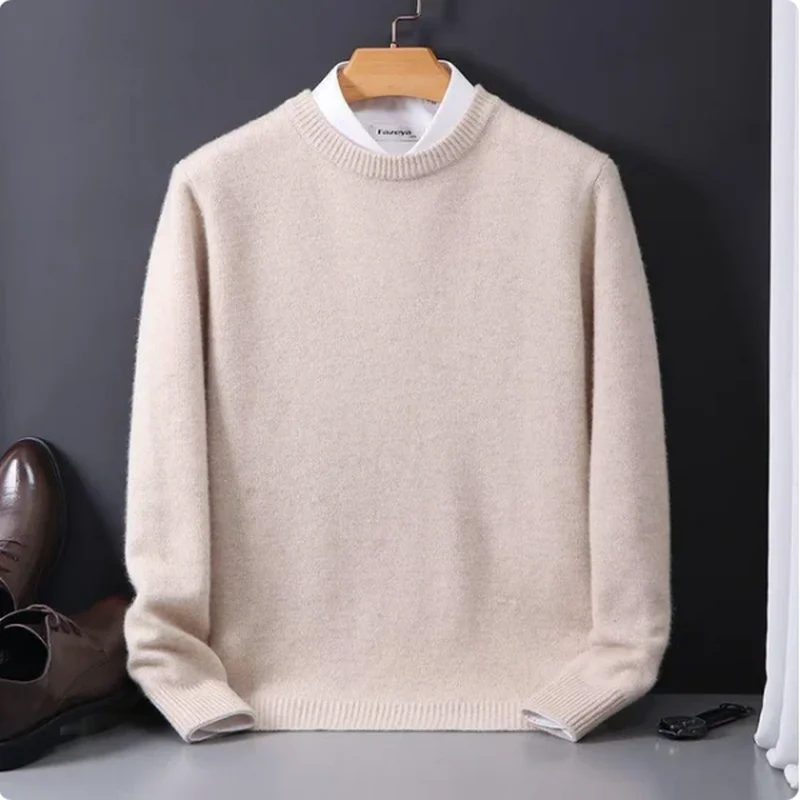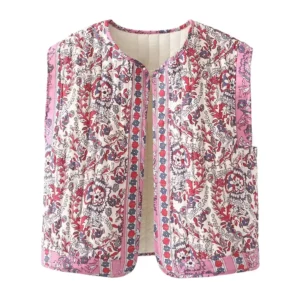1. What Makes Cashmere Truly Exceptional: Understanding Premium Quality
Cashmere has earned its reputation as one of the world’s most luxurious natural fibers. This exceptional material comes from the soft undercoat of specific breeds of cashmere goats, primarily found in some of the planet’s harshest environments. But not all cashmere is created equal – the quality can vary dramatically based on several key factors.
When evaluating cashmere quality, experts focus on several critical measurements:
Fiber diameter (micron count): The finer the fiber, the softer the cashmere. Premium cashmere typically measures under 16 microns in diameter. For perspective, human hair averages about 70-100 microns – making quality cashmere 4-6 times finer.
Staple length: Longer fibers (ideally exceeding 36mm) create stronger yarn that resists pilling and maintains its shape over time. This is why garments made with longer fibers look better for longer.
Color purity: Naturally white cashmere can be dyed to virtually any color without additional processing, while colored fibers may require bleaching before dyeing, potentially compromising fiber integrity.
Guard hair content: The less coarse guard hair present, the softer and more comfortable the final product. Premium cashmere contains less than 3% guard hair content.
The environment where cashmere goats live plays a crucial role in quality. Goats raised in regions with extremely cold winters and significant temperature fluctuations develop finer, denser undercoats as a survival mechanism. This is why some geographic areas consistently produce superior cashmere.
Understanding styling tips for cashmere cardigans becomes more meaningful when you appreciate the quality of the material you’re wearing. The cashmere industry classifies its products into grades – A, B, and C – with Grade A representing the finest quality with fibers under 16 microns thick and longest staple length. This grading system helps consumers make informed choices when selecting their cashmere sweaters.
2. Mongolia: Home to the World’s Finest Cashmere
Mongolia has earned its reputation as the producer of the world’s finest cashmere through a perfect combination of climate, tradition, and animal husbandry. The vast, windswept Mongolian Plateau creates ideal conditions for developing exceptional cashmere fibers.
Extreme Climate Advantage
The Mongolian climate is characterized by dramatic temperature extremes, with winter temperatures plummeting to -40°F (-40°C). These harsh conditions trigger a biological response in cashmere goats – they develop an incredibly fine, dense undercoat to survive. The greater the temperature fluctuation between seasons, the finer the cashmere fiber becomes.
Mongolia’s high altitude further enhances fiber development. The combination of altitude, dry air, and extreme cold creates the perfect environment for producing cashmere with remarkable insulating properties while maintaining extraordinary softness.
Distinctive Mongolian Cashmere Characteristics
Mongolian cashmere stands out for its exceptional measurements:
– Average fiber diameter: 14-16 microns (among the finest in the world)
– Typical staple length: 34-36mm (creating stronger, more durable yarn)
– Natural color range: Primarily white, but also including beautiful grays, browns, and creams
Traditional Harvesting Methods
Mongolian herders have refined their practices over centuries, using traditional hand-combing techniques during the spring molting season. This careful combing process separates the valuable undercoat from coarser guard hairs while causing minimal stress to the animals. Unlike machine shearing used in some regions, hand-combing collects only the naturally shed undercoat, resulting in longer fibers and less damage.
Nearly a third of Mongolia’s population is involved in cashmere production in some capacity, with nomadic herding families maintaining techniques passed down through generations. This traditional approach prioritizes quality over quantity – a philosophy increasingly rare in modern production.
Sustainability practices are deeply embedded in Mongolian herding culture. The nomadic lifestyle prevents overgrazing by continuously moving herds to fresh pastures, maintaining both the health of the goats and the quality of their cashmere. When selecting men’s cashmere pullovers, those featuring Mongolian cashmere often represent the pinnacle of quality.
3. The Himalayan Treasure: Ladakh’s Ultra-Fine Pashmina
While Mongolia produces exceptional cashmere, the remote Himalayan region of Ladakh (in Kashmir, India) creates what many consider the world’s most exclusive cashmere variety – Pashmina. The term “pashmina” often causes confusion in the marketplace, as it’s frequently misused for marketing purposes. True pashmina specifically refers to the ultra-fine cashmere harvested from Changthangi goats native to this high-altitude Himalayan plateau.
REGIONAL SPOTLIGHT: The Changthang Plateau in Ladakh sits at an astounding elevation above 14,000 feet (4,270 meters), making it one of the highest inhabited regions on Earth. Winter temperatures regularly drop to -40°F (-40°C).
The Changthangi goat (also called the Pashmina goat) has adapted to this extreme environment in remarkable ways. Their response to the harsh climate is the development of an incredibly fine undercoat, measuring just 10-14 microns in diameter – noticeably finer than even premium Mongolian cashmere. This extraordinary fineness creates a fiber that feels almost ethereal to the touch.
The harvesting process in Ladakh maintains traditional methods that have changed little over centuries. Local herders known as Changpas carefully hand-comb the molting undercoat from each goat during spring – a labor-intensive process that preserves the integrity of each precious fiber. Machine shearing is avoided entirely, as it would mix the valuable undercoat with coarser guard hairs.
What makes Ladakhi pashmina particularly special is the combination of fiber fineness and the region’s traditional processing methods. After collection, the fibers undergo minimal mechanical processing, often being hand-spun by local artisans. This preserves the natural characteristics of the fiber, resulting in a material with unmatched softness and a distinctive lightweight warmth.
The limited production capacity of this region contributes to its exclusivity – the harsh environment and traditional practices limit volume, making authentic Ladakhi pashmina rare in global markets. Understanding the differences between Mongolian vs. Scottish cashmere helps appreciate the unique qualities that different regions bring to this luxury material.
For those seeking the ultimate in luxury and softness, women’s cashmere turtlenecks made from Ladakhi pashmina represent perhaps the pinnacle of cashmere quality.
4. Comparing the World’s Top Cashmere Producers: Quality Analysis

When evaluating cashmere quality across different producing regions, several measurable factors reveal why certain areas consistently outperform others. The table below provides a comparative analysis of the major cashmere-producing countries:
| Country/Region | Average Fiber Diameter | Average Staple Length | Primary Harvesting Method | Market Quality Reputation |
|---|---|---|---|---|
| Mongolia | 14-16 microns | 34-36mm | Traditional hand-combing | Premium |
| Ladakh (India) | 10-14 microns | 36-40mm | Traditional hand-combing | Ultra-premium |
| China | 15-19 microns | 32-34mm | Mixed (machine/hand) | Variable (mid to high) |
| Iran | 16-19 microns | 30-34mm | Primarily hand-combing | Good to very good |
| Afghanistan | 16-18 microns | 30-34mm | Primarily hand-combing | Good |
What creates these quality differences? Geography plays the defining role. The combination of altitude, temperature extremes, and available vegetation directly impacts fiber development. The harshest environments consistently produce the finest fibers, as the goats develop denser, finer undercoats to survive extreme cold.
While Ladakh produces the finest fibers by micron count, its extremely limited production volume means Mongolian cashmere dominates the premium market segment. China, meanwhile, has focused on increasing production volume, sometimes at the expense of achieving the finest possible fiber.
The price differences between regions reflect these quality variations. Ultra-fine Ladakhi pashmina can command prices 3-5 times higher than standard Chinese cashmere. Mongolian premium cashmere typically sells at 1.5-2 times the price of average Chinese varieties, reflecting its consistently superior quality measurements.
For consumers, understanding these regional differences provides valuable context when evaluating cashmere products and their pricing. The highest quality fibers typically create garments that not only feel softer initially but maintain their appearance and performance significantly longer.
5. China: The World’s Largest Cashmere Producer
China dominates the global cashmere industry in pure production volume, accounting for approximately 70% of the world’s cashmere output. This massive production capacity has made cashmere more accessible to consumers worldwide, but quantity and quality don’t always align.
Chinese cashmere quality varies significantly depending on the specific region of production:
- Inner Mongolia (China): Produces China’s highest quality cashmere, with characteristics similar to neighboring Mongolia, though typically with slightly thicker fibers.
- Xinjiang Province: Medium-quality production with slightly thicker fibers than Inner Mongolia.
- Other Chinese regions: Generally produce standard-grade cashmere with less fineness.
The typical characteristics of Chinese cashmere include:
* Fiber diameter: Usually 15-19 microns (compared to Mongolia’s 14-16 microns)
* Staple length: Averaging 32-34mm (slightly shorter than premium Mongolian)
* Harvesting methods: Primarily machine harvesting, with some hand-combing in premium production
China’s industrialized approach to cashmere production has revolutionized the industry by increasing efficiency and reducing costs. Most Chinese cashmere is harvested through machine shearing rather than traditional hand-combing. While efficient, machine shearing collects both the fine undercoat and coarser guard hairs together, requiring more intensive separation during processing. This can sometimes compromise fiber length and quality.
This industrialization creates a distinct price-quality relationship in the market. Chinese cashmere offers excellent value at mid-range price points but rarely achieves the ultra-premium qualities found in traditional Mongolian or Ladakhi production. Understanding how to choose high-quality cashmere becomes particularly important when navigating the wide quality range within Chinese production.
For consumers, Chinese cashmere represents a broader spectrum of options – from reasonably priced everyday items to higher-end pieces from specialized Inner Mongolian production. The key is understanding that price generally reflects quality differences in fiber fineness, processing methods, and resulting longevity.
6. Other Notable Cashmere Producers: Iran, Afghanistan, and Nepal
Beyond the major producers, several other countries contribute significant cashmere to global markets, each with distinctive characteristics that reflect their unique environments.
Iran
- Fiber diameter: 16-19 microns (good quality but typically not as fine as Mongolian)
- Notable characteristics: Known for producing cashmere with excellent luster
- Production methods: Primarily traditional with hand-combing still common
- Market position: Mid to high-quality, with some premium production
Afghanistan
- Fiber diameter: 16-18 microns
- Notable characteristics: Often has slightly higher guard hair content but good overall quality
- Production challenges: Regional instability has impacted consistent production
- Traditional methods: Hand-harvesting remains common in remote areas
- Color range: Known for beautiful natural white cashmere ideal for dyeing
Nepal
- Fiber characteristics: Typically slightly coarser than premium Mongolian (17-19 microns)
- Distinctive approach: Often blends cashmere with other luxury fibers like yak wool
- Processing: Strong tradition of artisanal processing and hand-weaving
- Market position: Known for unique blended products rather than pure premium cashmere
These regions produce cashmere that would be considered good to very good quality by global standards, though they rarely achieve the exceptional fineness of Mongolian or Ladakhi fibers. Their production methods often remain more traditional than China’s industrialized approach, which helps preserve fiber quality despite geographic conditions that don’t create the finest possible undercoat.
For consumers interested in cashmere with unique characteristics or supporting diverse production regions, these countries offer interesting alternatives. Brushed cashmere sweaters often highlight the distinctive qualities of fibers from these varied regions, each bringing something special to the finished garment.
7. The Science Behind Superior Cashmere: Climate, Genetics, and Geography

The exceptional quality of cashmere from regions like Mongolia and Ladakh isn’t simply a matter of tradition or reputation – it’s rooted in biology, climate science, and animal adaptation. Understanding these scientific factors reveals why geography plays such a crucial role in determining fiber quality.
When cashmere goats experience extreme cold, their bodies respond by developing a protective undercoat with remarkable properties. The colder the environment, the finer the fibers become as they provide better insulation. This biological adaptation explains why goats in Mongolia and Ladakh – regions with temperatures frequently dropping below -40°F (-40°C) – produce the world’s finest cashmere.
Altitude compounds this effect. Higher elevations create more extreme temperature fluctuations between day and night, triggering even more pronounced fiber development. The Changthang Plateau in Ladakh, at over 14,000 feet (4,270 meters), represents perhaps the perfect combination of altitude and cold for developing ultra-fine cashmere fibers.
Dietary factors also influence fiber quality. Goats in premium producing regions consume a diverse diet of native plants, many containing minerals that strengthen fiber development. These natural forage patterns, maintained through nomadic herding, contrast with more limited diets in industrialized production.
Genetics plays its role as well. Over centuries, specific goat breeds have adapted to their environments through natural selection. The Changthangi goat of Ladakh and various Mongolian cashmere goat breeds represent the culmination of this evolutionary process – animals perfectly adapted to extreme environments who produce exceptional fiber as a survival mechanism.
This unique combination of factors – extreme cold, high altitude, genetic adaptation, and traditional herding practices – simply cannot be replicated in other environments. Attempts to transplant these goat breeds to milder climates invariably result in coarser fiber production as the biological need for the ultra-fine protective undercoat diminishes.
For consumers seeking the finest quality, understanding this science explains why cashmere from these specific regions consistently outperforms alternatives. Premium men’s cashmere turtlenecks derive their extraordinary softness and insulation properties directly from these environmental factors.
8. How to Identify High-Quality Cashmere: A Consumer’s Guide
Even with knowledge about regional differences in cashmere quality, consumers still need practical ways to evaluate cashmere when shopping. These simple tests can help identify premium cashmere regardless of labeled origin:
The Touch Test
Quality cashmere should feel incredibly soft but not slippery or artificial. Run the fabric between your fingers – premium cashmere creates a soft, warm sensation without scratchiness. Be cautious of pieces that feel suspiciously silky, as some manufacturers use chemical treatments to mimic softness that washes out over time.
The Stretch Test
Gently pull the fabric in different directions. High-quality cashmere will stretch slightly and then return to its original shape quickly. Poor quality cashmere or blends may stretch out and remain deformed. This recovery ability comes from longer fiber length in premium cashmere.
Visual Inspection
Examine the fabric surface carefully:
* Look for a slight haze or “bloom” on the surface – quality cashmere isn’t completely smooth
* Check for consistent color throughout
* Hold it against light – premium cashmere has a tight, even knit without thin spots
* Look for minimal surface fluff (1-2mm is ideal) – excessive fluffiness often indicates shorter fibers prone to pilling
The Pilling Test
Gently rub the surface of the fabric between your thumb and forefinger about 20 times. Lower quality cashmere will begin pilling immediately, while premium cashmere resists pilling due to longer fiber length.
Label Indicators
Beyond “100% cashmere,” look for:
* Mention of 2-ply or higher construction (indicates stronger, more durable yarn)
* Grade A designation (though this isn’t standardized across all brands)
* Information about fiber diameter (under 16 microns indicates premium quality)
Price Considerations
While not foolproof, price often reflects quality. Extremely inexpensive “cashmere” items rarely contain the highest quality fiber. Premium cashmere requires more selective harvesting and processing, which inevitably impacts price.
Cashmere Wrap Sweaters, Women's Cashmere Pullovers
$75.89 Select options This product has multiple variants. The options may be chosen on the product pageCashmere Cable Knit Sweaters, Women's Cashmere Pullovers
Price range: $111.82 through $112.93 Select options This product has multiple variants. The options may be chosen on the product page- Price range: $171.47 through $181.33 Select options This product has multiple variants. The options may be chosen on the product page
Cropped Cashmere Sweaters, Women's Cashmere Pullovers
$155.77 Select options This product has multiple variants. The options may be chosen on the product page- Price range: $87.29 through $91.47 Select options This product has multiple variants. The options may be chosen on the product page
Oversized Cashmere Sweaters, Plus Size Cashmere Sweaters, Women's V-Neck Cashmere Sweaters
$136.87 Select options This product has multiple variants. The options may be chosen on the product page
These evaluation techniques help you make informed decisions when shopping for cashmere. After purchasing quality pieces, understanding how to master wearing long cashmere cardigans will help you showcase your investment effectively.
9. Factors Affecting Cashmere Quality Beyond Geography
While geography largely determines the potential quality of cashmere fiber, several other factors significantly influence the quality of the final product. Even the finest raw cashmere can be compromised by poor harvesting and processing.
Harvesting Methods
- Hand-combing: Traditional hand-combing collects only the naturally shedding undercoat without cutting fibers. This preserves the fiber’s natural length and tapered ends, resulting in stronger yarn and less pilling.
- Machine shearing: More efficient but less selective, machine shearing cuts fibers rather than collecting naturally shed ones. This can result in shorter fiber length and more guard hair contamination.
Processing Techniques
- Traditional processing: Slower methods that handle fibers gently preserve their natural characteristics.
- Chemical processing: Harsh chemicals used to speed cleaning and dehairing can damage fiber integrity and reduce the cashmere’s natural properties.
Animal Factors
- Goat age: Prime cashmere typically comes from adult goats 3-6 years old. Very young or elderly goats produce less optimal fiber.
- Harvesting timing: Collection during the natural spring molting season yields better results than forced harvesting at other times.
Manufacturing Standards
- Dehairing quality: The thoroughness of guard hair removal significantly impacts softness.
- Spinning methods: Traditional slow spinning creates stronger, more resilient yarn than high-speed industrial methods.
The combination of ideal geography and careful processing creates truly exceptional cashmere. Mongolia and Ladakh’s reputation for premium cashmere stems not only from their perfect environmental conditions but also from their adherence to traditional harvesting and processing methods that preserve the natural quality of the fiber.
This explains why two products from the same region can differ significantly in quality – the journey from goat to garment involves many steps where quality can either be preserved or compromised.
10. Sustainable Practices in Premium Cashmere Production

The world’s finest cashmere isn’t just defined by fiber measurements – increasingly, sustainable and ethical production practices factor into both quality assessment and consumer preference. The relationship between sustainability and quality proves particularly strong in cashmere production.
In Mongolia, traditional nomadic herding practices have sustained cashmere production for centuries. Herding families move their goats seasonally to prevent overgrazing and maintain the health of grasslands. This mobility allows vegetation to recover and provides goats with varied nutrition that contributes to better fiber development. The result is healthier goats producing finer, stronger cashmere.
Similarly, in Ladakh, the Changpa nomads maintain small herds that move through vast territories, minimizing environmental impact. Their traditional knowledge includes understanding which pastures can support grazing without degradation, preserving the delicate high-altitude ecosystem.
The contrast with industrialized production is notable:
* Traditional herding: 20-100 goats per family, moved frequently across large territories
* Industrial farming: Can involve thousands of goats in more confined areas, creating higher risk of overgrazing
This difference impacts not just the environment but also fiber quality. Goats under environmental stress or with limited dietary diversity typically produce less fine fiber. The connection between animal welfare, environmental sustainability, and product quality becomes clear when examining premium cashmere production.
Several certification programs now help identify sustainably produced cashmere:
* The Sustainable Fibre Alliance (SFA)
* The Good Cashmere Standard
* Various organic and fair trade certifications
These certifications verify practices including responsible grazing management, animal welfare standards, and fair compensation for herders. For consumers interested in both quality and responsibility, exploring options for eco-friendly cashmere provides valuable guidance in making thoughtful purchasing decisions.
Estate Cloth recognizes this important connection between sustainability and quality, focusing on sourcing that respects both exceptional fiber standards and responsible production methods.
11. How Processing Methods Affect the Final Cashmere Product
The journey from raw cashmere fiber to finished garment involves multiple steps, each with the potential to either enhance or diminish the natural qualities that make cashmere exceptional. Understanding this process helps explain why two cashmere products with similar origins might differ dramatically in performance and feel.
The processing journey typically follows these steps:
Harvesting: As mentioned earlier, hand-combing preserves fiber integrity by collecting naturally molted undercoat without cutting. The combs separate much of the coarse guard hair at this first stage. Machine shearing, while faster, cuts fibers and collects both undercoat and guard hair together.
Sorting and Grading: Raw cashmere is sorted by color, diameter, and length. This critical quality control step determines which fibers are suitable for premium products.
Cleaning and Dehairing: The fiber undergoes washing to remove dirt, grease, and remaining guard hairs. Traditional methods use gentle washing and meticulous dehairing, while industrial processing may use chemical baths that clean effectively but potentially compromise fiber integrity.
Dying: Natural white cashmere accepts dye readily without pre-treatment. Colored cashmere may require bleaching before dyeing, which can slightly weaken fibers.
Carding and Spinning: Fibers are aligned and formed into yarn. Slower spinning creates stronger yarn with better pill resistance, while high-speed industrial spinning prioritizes efficiency.
Knitting/Weaving: The yarn becomes fabric. Tighter knits generally provide better durability, though proper tension is essential to maintain cashmere’s natural elasticity.
Finishing: Final treatments can include softening, slight felting to reduce pilling, or water-repellent coatings. Traditional finishing uses minimal intervention to preserve natural characteristics.
Each step affects the final product’s performance:
* Softness is primarily determined by fiber diameter but can be compromised by harsh processing
* Durability comes from fiber length and proper spinning techniques
* Pill-resistance depends on fiber length and finishing methods
* Color retention relates to dyeing processes and fiber health
This explains why cashmere from the same region can vary dramatically in quality and why some less expensive products may feel soft initially but quickly degrade with wear. The finest cashmere vests combine exceptional raw materials with careful processing that preserves the natural qualities that make cashmere so desirable.
12. Is the Highest Quality Cashmere Always from Mongolia or Ladakh?
While Mongolia and Ladakh consistently produce the world’s finest cashmere, the quality landscape is more nuanced than a simple geographical determination. Several factors complicate this picture:
Are there exceptions to the regional quality rule?
Yes. Individual farms within any region may outperform their region’s average through exceptional breeding programs and harvesting practices. Some Chinese Inner Mongolian producers, for example, create cashmere rivaling the best from Mongolia proper through careful herd management and processing.
Are new quality leaders emerging?
Some regions are showing promising quality improvements. Parts of Afghanistan have invested in improving their cashmere quality through better breeding and harvesting techniques. Similarly, certain Iranian producers have focused on creating premium-grade cashmere that approaches Mongolian standards.
How do breeding innovations affect quality geography?
Selective breeding programs aim to develop goats that produce finer fiber even in less extreme environments. While these efforts have shown some success, they haven’t yet overcome the fundamental biological response to extreme cold that creates the finest natural fibers.
Does blending change the quality equation?
Some manufacturers blend fibers from different regions to balance quality and cost. A blend might combine Mongolian and Chinese cashmere to achieve a price point between the two while maintaining acceptable softness.
The general rule about Mongolia and Ladakh producing the finest cashmere remains valid, but consumers should remember that quality exists on a spectrum. Exceptional producers can be found in various regions, and poor processing can diminish even the finest raw materials. The country of origin provides strong guidance but shouldn’t be the only quality consideration.
13. How Climate Change is Affecting Global Cashmere Quality
Climate change poses significant challenges to traditional cashmere-producing regions, potentially altering the very conditions that have created the world’s finest fibers. These environmental shifts may reshape the geography of premium cashmere production in coming decades.
In Mongolia, average temperatures have risen faster than the global average, with some regions experiencing warming of over 4°F (2.2°C) in recent decades. This warming trend directly impacts cashmere quality, as goats produce finer fibers in response to extreme cold. With milder winters, fibers may become slightly coarser over time.
Climate change also affects precipitation patterns, with many traditional cashmere regions experiencing increased drought frequency. This impacts vegetation available to grazing goats, potentially affecting both their health and fiber quality. Changing patterns have forced some herders to modify their traditional migration routes to find suitable grazing.
In Ladakh, glacial retreat threatens water supplies that sustain both pastures and communities. The delicate high-altitude ecosystem that supports Changthangi goats faces mounting pressure from changing weather patterns.
Adaptation strategies being implemented include:
* More careful herd management to prevent overgrazing stressed vegetation
* Selective breeding to maintain fiber fineness despite climate changes
* Water conservation techniques to sustain pastures during droughts
* Diversification of income sources for herding communities
These environmental changes don’t just threaten product quality but also the cultural heritage and livelihoods of traditional herding communities that have maintained premium cashmere production for centuries. Understanding the environmental impact of cashmere production helps consumers make informed choices that support both quality and sustainability.
The premium cashmere industry faces the challenge of adapting to these changing conditions while maintaining the exceptional quality standards that define luxury cashmere. How successfully producers navigate these challenges will shape the future geography of the world’s finest cashmere.







